Tarantula
This article needs additional citations for verification. (February 2016) |
| Tarantula Temporal range:
| |
|---|---|

| |
| Tliltocatl vagans | |
| Scientific classification | |
| Domain: | Eukaryota |
| Kingdom: | Animalia |
| Phylum: | Arthropoda |
| Subphylum: | Chelicerata |
| Class: | Arachnida |
| Order: | Araneae |
| Infraorder: | Mygalomorphae |
| Clade: | Avicularioidea |
| Family: | Theraphosidae Thorell, 1869 |
| Diversity[1] | |
| 166 genera, 1,100 species | |

| |
Tarantulas comprise a group of large and often hairy
Overview
Like all
Depending on the species, the body length of tarantulas ranges from about 5 to 11 cm (2 to 4+1⁄2 in)[6] with leg spans of 8–30 cm (3–12 in).[citation needed] Leg span is determined by measuring from the tip of the back leg to the tip of the front leg on the opposite side. Some of the largest species of tarantula may weigh over 85 g (3 oz); the largest of all, the goliath birdeater (Theraphosa blondi) from Venezuela and Brazil, has been reported to attain a weight of 170 g (6 oz)[7] and a leg-span up to 30 cm (12 in), males being longer and females greater in girth. The fang size of this tarantula reaches a maximum of 4 cm (1+1⁄2 in).[7]
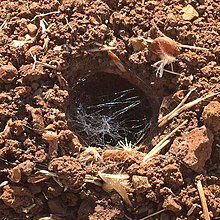
Theraphosa apophysis (the pinkfoot goliath) was described 187 years after the goliath birdeater, so its characteristics are not as well attested. T. blondi is generally thought to be the heaviest tarantula, and T. apophysis has the greatest leg span. Two other species, Lasiodora parahybana (the Brazilian salmon birdeater) and Lasiodora klugi, rival the size of the two goliath spiders.

Most species of
Tarantulas are becoming increasingly popular as pets and some species are readily available in captivity.
Identification
Tarantulas can be confused with other members of the order
One of the most decisive ways to tell is by looking at their fangs. Tarantula fangs face downwards, as opposed to those of true spiders, which face each other, allowing them to make pincerlike motions. They also own two book lungs, as opposed to true spiders which only have one. Their lifespan is also longer than most spiders.[8]
-
A Phidippus johnsoni jumping spider's fangs
-
A Lasiodora parahybana tarantula's fangs

Etymology
The spider originally bearing the name tarantula was 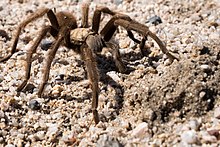
The name tarantula is also incorrectly applied to other large-bodied spiders, including the
The element pelma in genus names
Many theraphosid genera have names, either accepted or synonymous, containing the element pelma. This can be traced back to Carl Ludwig Koch in 1850,[11] who in describing his new genus Eurypelma wrote, "Die Sammetbürste der Fussohlen sehr breit" (lit. 'the velvet-brush of the footsole very wide').[12] German arachnologists use the word Fuß to refer to the tarsus (the last article of a spider's leg).[13] Translations of Sammetbürste into Latin use the word scopula.[14] Hence in English arachnological terminology, Koch meant 'the scopula of the base of the tarsus very wide'. Eury- is derived from the Greek eurýs (εὐρύϛ), meaning 'wide', while pélma (πέλμα) means 'the sole of the foot',[11] paralleling Koch's use of Fußsohle (in modern spelling). Thus Eurypelma literally means 'wide footsole'; however, arachnologists have conventionally taken pelma in such names to refer to the scopula, so producing the meaning 'with a wide scopula'.[11]
Other genus names or synonyms that Estrada-Alvarez and Cameron regard as having 'footsole' or 'scopula' meanings include:[11]
- Acanthopelma – Greek ácantha (ἄκανθα) 'thorn, spine'; overall meaning 'spiny footsole'
- Brachypelma – Greek brachýs (βραχύϛ) 'short'; overall meaning 'short scopula'
- Metriopelma – Greek métrios (μέτριοϛ) 'of moderate size'; overall meaning 'medium length scopula'
- Schizopelma – from the Greek origin combining form schizo- (σχίζω) 'split'; overall meaning 'split footsole'
- Sericopelma – Greek sericós (σηρικόϛ) 'silky'; overall meaning 'silken scopula'
Later, particularly following genus names published by R.I. Pocock in 1901,[15] the element pelma appears to have become synonymous with 'theraphosid'. For example, the author of Cardiopelma writes, "Cardiopelma fait réference aux genitalia de la femelle qui évoquent la forme d'un Coeur" ('Cardiopelma refers to the female genitalia that evoke the shape of a heart'), with no reference to either 'footsole' or 'scopula'. Names interpreted in this way include:[11]
- Aphonopelma – Greek áphonos (ἄφωνοϛ) 'soundless'; overall meaning 'theraphosid without sound'
- Cardiopelma – Greek cardía (καρδία) 'heart'; overall meaning 'heart theraphosid' (referring to the heart-shaped female genitalia)
- Clavopelma – Latin clavis 'club'; overall meaning 'theraphosid with club-shaped hairs'
- Delopelma – Greek delós (δηλόϛ) 'clear, obvious, visible, conspicuous, plain'; overall meaning 'theraphosid without plumose hair'
- Gosipelma – the element gosi- means 'desert', relating to the Gosiute people; overall meaning 'desert theraphosid'
- Spelopelma – Greek spélaion (σπήλαιον) 'cave'; overall meaning 'cave theraphosid'
Distribution
Tarantulas of various species occur throughout the United States, Mexico, in Central America, and throughout South America. Other species occur variously throughout Africa, much of Asia (including the Ryukyu Islands in southern Japan), and all of Australia. In Europe, some species occur in Spain, Portugal, Turkey, southern Italy, and Cyprus.
Habits
Some
Appendages
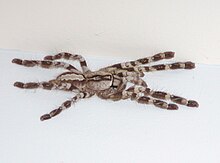
The eight legs, the two chelicerae with their fangs, and the
The pedipalpi are two six-segmented appendages connected to the prosoma near the mouth and protruding on either side of both chelicerae. In most species of tarantulas, the pedipalpi contain sharp, jagged plates used to cut and crush food often called the


A tarantula has four pairs of legs and two additional pairs of appendages. Each leg has seven segments, which from the prosoma out are: coxa, trochanter, femur, patella, tibia, tarsus and pretarsus, and claw. Two or three retractable claws at the end of each leg are used to grip surfaces for climbing. Also on the end of each leg, surrounding the claws, is a group of bristles, called the scopula, which help the tarantula to grip better when climbing surfaces such as glass. The fifth pair is the pedipalps, which aid in feeling, gripping prey, and mating in the case of a mature male. The sixth pair of appendages is the chelicerae and their attached fangs. When walking, a tarantula's first and third legs on one side move at the same time as the second and fourth legs on the other side of its body. The muscles in a tarantula's legs cause the legs to bend at the joints, but to extend a leg, the tarantula increases the pressure of haemolymph entering the leg.
Tarantulas, like almost all other spiders, have their primary spinnerets at the end of the opisthosoma. Unlike most spider species in the infraorder Araneomorphae, which includes the majority of extant spider species, and most of which have six, tarantula species have two or four spinnerets. Spinnerets are flexible, tube-like structures from which the spider exudes its silk. The tip of each spinneret is called the spinning field. Each spinning field is covered by as many as 100 spinning tubes through which silk is exuded. As the silk is pulled out of the spinnerets, the shear forces cause proteins in the silk to crystallize, transforming it from a liquid to a solid thread.
Digestive system

The tarantula's mouth is located under its chelicerae on the lower front part of its prosoma. The mouth is a short, straw-shaped opening that can only suck, meaning that anything taken into it must be in liquid form. Prey with large amounts of solid parts, such as mice, must be crushed and ground up or predigested, which is accomplished by coating the prey with digestive juices secreted from openings in the chelicerae.
The tarantula's digestive organ (stomach) is a tube that runs the length of its body. In the
Nervous system
A tarantula's central nervous system (brain) is located in the bottom of the inner prosoma. A tarantula perceives its surroundings primarily via sensory organs called setae (bristles or spines, sometimes referred to as hairs). Although a tarantula has eight eyes like most spiders, touch is its keenest sense, and in hunting, it primarily depends on vibrations given off by the movements of its prey. A tarantula's setae are very sensitive organs and are used to sense chemical signatures, vibrations, wind direction, and possibly even sound. Tarantulas are also very responsive to the presence of certain chemicals such as pheromones.
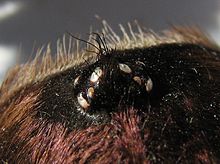
The eyes are located above the chelicerae on the forward part of the prosoma. They are small and usually set in two rows of four. Most tarantulas are not able to see much more than light, darkness, and motion. Arboreal tarantulas generally have better vision compared with terrestrial tarantulas.
Respiratory system
All types of tarantulas have two sets of book lungs (breathing organs); the first pair is located in a cavity inside the lower front part of the abdomen near where the abdomen connects to the cephalothorax, and the second pair is slightly farther back on the abdomen. Air enters the cavity through a tiny slit on each side of and near the front of the abdomen. Each lung consists of 15 or more thin sheets of folded tissue arranged like the pages of a book. These sheets of tissue are supplied by blood vessels. As air enters each lung, oxygen is taken into the blood stream through the blood vessels in the lungs. Needed moisture may also be absorbed from humid air by these organs.
Circulatory system

A tarantula's blood is unique (not only in appearance); an oxygen-transporting protein is present (the copper-based
The tarantula's heart is a long, slender tube located along the top of the opisthosoma. The heart is neurogenic as opposed to myogenic, so nerve cells instead of muscle cells initiate and coordinate the heart. It pumps hemolymph to all parts of the body through open passages often referred to as sinuses, and not through a circular system of blood vessels. If the exoskeleton is breached, loss of hemolymph will kill the spider unless the wound is small enough that the hemolymph can dry and close it.
Predators
Despite their large size and fearsome appearance and reputation, tarantulas themselves are prey for many other animals. The most specialized of these predators are large members of the wasp family
Tarantulas are also preyed upon by a wide variety of vertebrates. Many of these, including lizards, frogs, birds, snakes and mammals, are generalist predators of all kinds of large arthropods. Mammals that have been known to prey on tarantulas, such as the coati, kinkajou, and opossum in the New World, and mongooses and the honey badger in the Old World, are often immune to the venom of their arthropod prey.
Humans also consume tarantulas for food in their native ranges. They are considered a delicacy in certain cultures (e.g. Venezuela[19] and Cambodia). They can be roasted over an open fire to remove the bristles (described further below) and then eaten.

Tarantulas have evolved specialized bristles, or
To predators and other enemies, these bristles can range from being lethal to simply being a deterrent. With humans, they can cause irritation to eyes, nose, and skin, and more dangerously, the lungs and airways, if inhaled. The symptoms range from species to species, from person to person, from a burning itch to a minor rash. In some cases, tarantula bristles have caused permanent damage to human eyes.[4]
Some setae are used to stridulate, which makes a hissing sound. These bristles are usually found on the chelicerae. Stridulation seems to be more common in Old World species.
Bites and urticating bristles

All tarantulas are venomous. Although their
Before biting, a tarantula may signal its intention to attack by rearing up into a "threat posture", which may involve raising its prosoma and lifting its front legs into the air, spreading and extending its fangs, and (in certain species) making a loud hissing by stridulating. Tarantulas often hold this position for longer than the duration of the original threat. Their next step, without biting, may be to slap down on the intruder with their raised front legs. If that response fails to deter the attacker, the tarantulas of the Americas may next turn away and flick urticating hairs toward the pursuing predator. The next response may be to leave the scene entirely, but especially if no line of retreat is available, their final response may also be to whirl suddenly and bite. Some tarantulas are well known to give "dry bites", i.e., they may defensively bite some animal that intrudes on their space and threatens them, but they do not pump venom into the wound.
New-world tarantulas—those indigenous to the Americas—have bites that generally pose little threat to humans (other than causing localized pain). Most of them are equipped with urticating hairs on their abdomens, and almost always throw these barbed bristles as the first line of defense. These bristles irritate sensitive areas of the body and especially seem to target curious animals that may sniff these bristles into the mucous membranes of the nose. Some species have more effective urticating bristles than others. The goliath birdeater is known for its particularly irritating urticating bristles. They can penetrate the cornea, so eye protection should be worn when handling such tarantulas.[22]
Old World tarantulas have no urticating bristles and are more likely to attack when disturbed. They often have more potent, medically significant venom, and are faster and much more nervous and defensive than New World species.
Some dangerous spider species are related to tarantulas and are frequently confused with them. A popular
Sexual dimorphism
Some tarantula species exhibit pronounced

A juvenile male's sex can be determined by looking at a cast
Life cycle
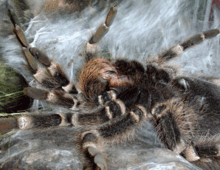
Like other spiders, tarantulas have to shed their exoskeleton periodically as they grow, a process called molting. A young tarantula may do this several times a year as a part of the maturation process, while full-grown specimens only molt once a year or less, or sooner, to replace lost limbs or lost urticating hairs. It is visibly apparent that molting is imminent when the exoskeleton takes on a darker shade. If a tarantula previously used its urticating hairs, the bald patch turns from a peach color to deep blue. The tarantula also stops feeding and becomes more lethargic during this time.
While most Tarantulas species take between two and five years to reach sexual maturity, some species can take up to 10 years. Upon reaching adulthood, males typically have an 18-month period left to live so immediately go in search of a female mate. Although females continue to molt after reaching maturity, males rarely do again once they reach adulthood. Those that do often can become stuck during the molting process due to their sexual organs and die.
Females can live for 30 to 40 years.
Reproduction

After reaching sexual maturity, a female tarantula normally mates and lays eggs once per year,[28][29] although they do not always do so.[30]
As with other spiders, the mechanics of intercourse are quite different from those of mammals. Once a male spider reaches maturity and becomes motivated to mate, he weaves a web mat on a flat surface. The spider then rubs his abdomen on the surface of this mat, and in so doing, releases a quantity of semen. He may then insert his pedipalps (short, leg-like appendages between the chelicerae and front legs) into the pool of semen. The pedipalps absorb the semen and keep it viable until a mate can be found. When a male spider detects the presence of a female, the two exchange signals to establish that they are of the same species. These signals may also lull the female into a receptive state. If the female is receptive, then the male approaches her and inserts his pedipalps into an opening in the lower surface of her abdomen, the opisthosoma. After the semen has been transferred to the receptive female's body, the male swiftly leaves the scene before the female recovers her appetite. Although females may show some aggression after mating, the male rarely becomes a meal.[citation needed][9]
Females deposit 50 to 2,000 eggs, depending on the species, in a silken egg sac and guard it for six to eight weeks. During this time, the females stay very close to the egg sacs and become more aggressive. Within most species, the females turn the egg sac often, which is called brooding. This keeps the eggs from deforming due to sitting in one position too long. The young spiderlings remain in the nest for some time after hatching, where they live off the remains of their yolk sacs before dispersing.[citation needed][31]
Taxonomy
Subfamilies
A 2019
The relationship between the subfamilies found in the study is shown in the following cladogram.[34] The dual placing of Ischnocolinae is highlighted.
| Theraphosidae |
| ||||||||||||||||||||||||||||||||||||
All the species that possess urticating hairs and have been seen to use them in bombardment behavior are placed in the "bombardier clade", although not all species in the included subfamilies possess such hairs (all Schismatothelinae lack them as do most Psalmopoeinae genera). It is not clear whether the possession of urticating hairs was an ancestral trait of the clade, and has been lost in some species, or whether it represents multiple gains. Foley et al. suggested that the second hypothesis appeared to be better supported.[34]
Other subfamilies that have been recognized include:[citation needed]
- Acanthopelminae– may be treated as synonymous with Ischnocolinae
- Selenogyrinae
- Spelopelminae – typically not accepted, Hemirrhagus being treated as Theraphosinae
Genera
As of December 2023[update], the World Spider Catalog accepted the following genera:[1]
- Abdomegaphobema Sherwood, Gabriel, Peñaherrera-R., Léon-E., Cisneros-Heredia, Brescovit & Lucas, 2023
- Acanthopelma F. O. Pickard-Cambridge, 1897 – Guyana
- Acanthoscurria Ausserer, 1871 – South America, Guatemala
- Acentropelma Pocock, 1901 – Belize, Mexico, Guatemala
- Aenigmarachne Schmidt, 2005 – Costa Rica
- Agnostopelma Pérez-Miles & Weinmann, 2010 – Colombia
- AguapanelaPerafán & Cifuentes, 2015
- Amazonius Cifuentes & Bertani, 2022 - South America
- Annandaliella Hirst, 1909 – India
- Anoploscelus Pocock, 1897 – Uganda, Tanzania, Rwanda
- Anqasha Sherwood & Gabriel, 2022 - Peru
- Antikuna Kaderka, Ferretti, West, Lüddecke & Hüsser, 2021 - Peru
- Antillena Bertani, Huff & Fukushima, 2017 – Dominican Republic
- Aphonopelma Pocock, 1901 – North America, Central America
- Augacephalus Gallon, 2002 – South Africa, Mozambique, Eswatini
- Avicularia Lamarck, 1818 – South America, Trinidad and Tobago, Panama
- Bacillochilus Gallon, 2010 – Angola
- Batesiella Pocock, 1903 – Cameroon
- Bermejoa Gabriel, Sherwood & Pérez-Miles, 2023
- Birupes Gabriel & Sherwood, 2019 – Malaysia
- Bistriopelma Kaderka, 2015 – Peru
- Bonnetina Vol, 2000 – Mexico
- Brachionopus Pocock, 1897 – South Africa
- Brachypelma Simon, 1891 – Mexico, Costa Rica, Guatemala
- Bumba Pérez-Miles, Bonaldo & Miglio, 2014 – Brazil, Venezuela, Ecuador
- Cardiopelma Vol, 1999 – Unknown
- Caribena Fukushima & Bertani, 2017 – Cuba
- Catanduba Yamamoto, Lucas & Brescovit, 2012 – Brazil
- Catumiri Guadanucci, 2004 – South America
- Ceratogyrus Pocock, 1897 – Africa
- Chaetopelma Ausserer, 1871 – Asia, Greece, Africa
- Chilobrachys Karsch, 1892 – Asia
- Chinchaysuyu Ferretti, Chaparro, Ochoa & West, 2023
- ChromatopelmaSchmidt, 1995 – Venezuela
- Citharacanthus Pocock, 1901 – Cuba, Central America, Mexico
- Citharognathus Pocock, 1895 – Indonesia
- Clavopelma Chamberlin, 1940 – Mexico
- Coremiocnemis Simon, 1892 – Malaysia, Indonesia, Australia
- Cotztetlana Mendoza, 2012 – Mexico
- Crassicrus Reichling & West, 1996 – Mexico, Belize
- Cubanana Ortiz, 2008 – Cuba
- Cyclosternum Ausserer, 1871 – South America, Mexico, Costa Rica
- Cymbiapophysa Gabriel & Sherwood, 2020
- Cyriocosmus Simon, 1903 – South America, Trinidad and Tobago
- Cyriopagopus Simon, 1887 – Asia
- Cyrtogrammomma Pocock, 1895 - Guyana and Brazil
- Cyrtopholis Simon, 1892 – Caribbean
- Davus O. Pickard-Cambridge, 1892 – Central America, Mexico
- Dolichothele Mello-Leitão, 1923 – Brazil, Bolivia
- DugesiellaPocock, 1901 - Mexico
- Encyocratella Strand, 1907 – Tanzania
- Encyocrates Simon, 1892 – Madagascar
- Ephebopus Simon, 1892 – Suriname, Brazil
- Euathlus Ausserer, 1875 – Chile, Argentina
- Eucratoscelus Pocock, 1898 – Kenya, Tanzania
- Eumenophorus Pocock, 1897 – Sierra Leone
- Eupalaestrus Pocock, 1901 – South America
- Euphrictus Hirst, 1908 – Cameroon, Congo
- Euthycaelus Simon, 1889 – Colombia, Venezuela
- Grammostola Simon, 1892 – South America
- Guyruita Guadanucci, Lucas, Indicatti & Yamamoto, 2007 – Brazil, Venezuela
- Hapalopus Ausserer, 1875 – South America, Panama
- Hapalotremus Simon, 1903 – Bolivia, Peru, Argentina
- Haploclastus Simon, 1892 – India
- Haplocosmia Schmidt & von Wirth, 1996 – Nepal
- Harpactira Ausserer, 1871 – South Africa, Namibia
- Harpactirella Purcell, 1902 – South Africa, Morocco
- Hemirrhagus Simon, 1903 – Mexico
- Heterophrictus Pocock, 1900 – India
- Heteroscodra Pocock, 1900 – Cameroon, Gabon, Congo
- Heterothele Karsch, 1879 – Africa, Argentina
- Holothele Karsch, 1879 – Caribbean, South America
- Homoeomma Ausserer, 1871 – South America
- Hysterocrates Simon, 1892 – Africa
- Idiothele Hewitt, 1919 – South Africa
- Iridopelma Pocock, 1901 – Brazil
- Ischnocolus Ausserer, 1871 – Africa, Asia, Brazil, Europe
- Isiboroa Gabriel, Sherwood & Pérez-Miles, 2023
- Kankuamo Perafán, Galvis & Pérez-Miles, 2016
- Kochiana Fukushima, Nagahama & Bertani, 2008 – Brazil
- Lampropelma Simon, 1892 – Indonesia, Malaysia, Singapore
- Lasiocyano Galleti-Lima, Hamilton, Borges & Guadanucci, 2023 – Brazil
- Lasiodora C. L. Koch, 1850 – South America, Costa Rica
- Lasiodorides Schmidt & Bischoff, 1997 – Ecuador, Peru
- Longilyra Gabriel, 2014 – El Salvador
- Loxomphalia Simon, 1889 – Tanzania
- Loxoptygus Simon, 1903 – Ethiopia
- Lyrognathus Pocock, 1895 – Indonesia, India, Malaysia
- Magnacarina Mendoza, Locht, Kaderka, Medina & Pérez-Miles, 2016 – Mexico
- Mascaraneus Gallon, 2005 – Mauritius
- Megaphobema Pocock, 1901 – Costa Rica, Colombia, Ecuador
- Melloina Brignoli, 1985 – Panama, Venezuela
- Melognathus Chamberlin, 1917
- Metriopelma Becker, 1878 – Mexico
- Miaschistopus Pocock, 1897 – Venezuela
- Monocentropus Pocock, 1897 – Yemen, Madagascar
- Munduruku Miglio, Bonaldo & Pérez-Miles, 2013
- Murphyarachne Sherwood & Gabriel, 2022 - Peru
- Mygalarachne Ausserer, 1871 – Honduras
- Myostola Simon, 1903 – Gabon, Cameroon
- Neischnocolus Petrunkevitch, 1925 – Panama
- Neoheterophrictus Siliwal & Raven, 2012 – India
- Neoholothele Guadanucci & Weinmann, 2015 – Colombia, Trinidad and Tobago, Venezuela
- Neostenotarsus Pribik & Weinmann, 2004 – French Guiana
- Nesiergus Simon, 1903 – Seychelles
- Nesipelma Schmidt & Kovařík, 1996 – St. Kitts and Nevis
- Nhandu Lucas, 1983 – Brazil, Paraguay
- Omothymus Thorell, 1891 – Malaysia
- Ornithoctonus Pocock, 1892 – Myanmar, Thailand
- Orphnaecus Simon, 1892 – Papua New Guinea, Philippines
- Ozopactus Simon, 1889 – Venezuela
- Pachistopelma Pocock, 1901 – Brazil
- Pamphobeteus Pocock, 1901 – South America, Panama
- Parvicarina Galleti-Lima, Hamilton, Borges & Guadanucci, 2023
- PelinobiusKarsch, 1885 – Kenya, Tanzania
- Phlogiellus Pocock, 1897 – Asia, Papua New Guinea
- Phoneyusa Karsch, 1884 – Africa
- Phormictopus Pocock, 1901 – Cuba, Argentina, Brazil
- Phormingochilus Pocock, 1895 – Indonesia
- Phrixotrichus Simon, 1889 – Chile, Argentina
- Plesiopelma Pocock, 1901 – South America
- Plesiophrictus Pocock, 1899 – India, Micronesia, Sri Lanka
- Poecilotheria Simon, 1885 – Sri Lanka, India
- ProshapalopusMello-Leitão, 1923 – Brazil, Colombia
- Psalistops Simon, 1889 - Colombia and Venezuela
- Psalmopoeus Pocock, 1895 – Trinidad, South America, Central America, Mexico
- Psednocnemis West, Nunn & Hogg, 2012 – Malaysia, Indonesia
- Pseudhapalopus Strand, 1907 – South America, Trinidad
- PseudoschizopelmaSmith, 1995 - Mexico
- Pterinochilus Pocock, 1897 – Africa
- Pterinopelma Pocock, 1901 – Brazil
- Reichlingia Rudloff, 2001 – Belize
- Reversopelma Schmidt, 2001 – Ecuador or Peru
- Sahydroaraneus Mirza & Sanap, 2014 – India
- Sandinista Longhorn & Gabriel, 2019
- Schismatothele Karsch, 1879 – Venezuela, Colombia
- Schizopelma F. O. Pickard-Cambridge, 1897 – Mexico
- Scopelobates Simon, 1903 – Dominican Republic
- Selenocosmia Ausserer, 1871 – Oceania, Asia
- Selenogyrus Pocock, 1897 – Côte d'Ivoire, Sierra Leone
- Selenotholus Hogg, 1902 – Australia
- Selenotypus Pocock, 1895 – Australia
- Sericopelma Ausserer, 1875 – Central America, Brazil, Mexico
- Sickius Soares & Camargo, 1948 – Brazil
- Sphaerobothria Karsch, 1879 – Costa Rica, Panama
- Spinosatibiapalpus Gabriel & Sherwood, 2020
- Stichoplastoris Rudloff, 1997 – El Salvador, Costa Rica, Panama
- Stromatopelma Karsch, 1881 – Africa
- Taksinus Songsangchote, Sippawat, Khaikaew & Chomphuphuang, 2022 - Thailand
- Tapinauchenius Ausserer, 1871 – South America, Saint Vincent and the Grenadines
- Tekoapora Galleti-Lima, Hamilton, Borges & Guadanucci, 2023
- Thalerommata Ausserer, 1875 — Colombia, Mexico
- Theraphosa Thorell, 1870 – South America
- Thrigmopoeus Pocock, 1899 – India
- Thrixopelma Schmidt, 1994 – Peru, Chile
- Tliltocatl - Mexico, Costa Rica, Guatemala
- Tmesiphantes Simon, 1892 – Brazil
- Trichognathella Gallon, 2004 – South Africa
- Trichopelma Simon, 1888 – Caribbean, South America, Central America
- Typhochlaena C. L. Koch, 1850 – Brazil
- Umbyquyra Gargiulo, Brescovit & Lucas, 2018 – Bolivia, Brazil
- Urupelma Kaderka, Lüddecke, Řezáč, Řezáčová & Hüsser, 2023
- Vitalius Lucas, Silva & Bertani, 1993 – Brazil, Argentina
- Xenesthis Simon, 1891 – Panama, Venezuela, Colombia
- Yanomamius Bertani & Almeida, 2021 – Brazil, Venezuela
- Ybyrapora Fukushima & Bertani, 2017 – Brazil
Former genera:
- Ami Pérez-Miles, 2008 → Neischnocolus
- Barropelma Chamberlin, 1940 → Neischnocolus
- Eurypelmella Strand, 1907, nomen dubium
- Magulla Simon, 1892 → Tmesiphantes
- Melloleitaoina Gerschman & Schiapelli, 1960 → Tmesiphantes
Fossil record
Fossils of mygalomorph spiders date back to the Triassic.[citation needed] One species assigned to the Theraphosidae is Protertheraphosa spinipes, found in Burmese amber, which is dated to the mid and late Cretaceous.[35]
See also
References
- ^ a b "Family: Theraphosidae Thorell, 1869". World Spider Catalog. Natural History Museum Bern. Retrieved 2 May 2022.
- ISBN 978-0-7641-3885-0.
- ^ "Currently valid spider genera and species", World Spider Catalog, Natural History Museum Bern, retrieved 20 August 2022
- ^ PMID 9183200.
- ^ Pomeroy, R. (2014, February 4). Pub. Real Clear Science, "Spiders, and Their Amazing Hydraulic Legs and Genitalia". Retrieved October 13, 2019, from https://www.realclearscience.com/blog/2013/02/spiders-their-amazing-hydraulic-legs-and-genitals.html.
- ^ Jovan, Dennis, Kj, & Kenneth. (2019, May 1). Theraphosa blondi. Retrieved October 13, 2019, from https://www.theraphosidae.be/en/theraphosa-blondi/ Archived 18 May 2021 at the Wayback Machine.
- ^ a b Lewis, Tanya (17 October 2014). "Goliath Encounter: Puppy-Sized Spider Surprises Scientist in Rainforest". LiveScience.com. Live Science. Archived from the original on 4 December 2014. Retrieved 29 November 2014.
- ^ a b "Tarantula vs Other Spiders – 7 Key Differences – Fauna Facts". Retrieved 15 July 2022.
- ^ a b Fabre, Jean-Henri; Translated by Alexander Teixeira de Mattos (1916) The Life of the spider, Dodd, Mead, New York.
- ^ "Taranto". lifeinitaly. Archived from the original on 4 September 2015. Retrieved 29 August 2015.
- ^ a b c d e Estrada-Alvarez, Julio C. & Cameron, H.D. (2012). "Etymological origins of the generic names of Mexican tarantulas (Araneae:Theraphosidae)". Revista Ibérica de Aracnología (21): 153–160. Retrieved 10 October 2019.
- .
- ISBN 3-13-575802-8.
- OCLC 669374426. Retrieved 10 October 2019.
- .
- ^ Kovařík, F (2001), Chov sklípkanů (Keeping Tarantulas); Madagaskar, Jihlava, p. 23
- ISBN 0313339228.
- ^ "Wild or Giant Centipedes versus Other Predators". howtogetridofhousecentipedes. Archived from the original on 4 March 2016. Retrieved 29 August 2015.
- ^ Murton, Willow. "Tarantula kebab anyone?". BBC Food Blog, with video from Human Planet. BBC. Archived from the original on 6 December 2011. Retrieved 7 December 2011.
- hdl:2246/2705.
- ISBN 978-80-901466-5-5. Archivedfrom the original on 31 December 2013.
- ^ Tarantula shoots sharp bristles into owner's eye NBC News/LiveScience
- ^ Huntsman Spiders Archived 12 July 2009 at the Wayback Machine at The Australian Wonder Book of Knowledge
- S2CID 55978068.
- ^ Gallon, R. C. (2003). "A new African arboreal genus and species of theraphosid spider (Araneae, Theraphosidae, Stromatopelminae) which lacks spermathecae" (PDF). Bulletin of the British Arachnological Society. 12 (9): 405–411.
- ^ ISBN 0764100769.
- ^ Animal-World. "Rose-haired Tarantula". Animal World. Archived from the original on 11 January 2017. Retrieved 13 February 2017.
- S2CID 85259715.
Mygalomorph spiders are well-suited models for biogeographical analysis... They are long-lived and univoltine, and show high local endemicity.
- ISBN 9789004156647.
- ^ Punzo, Fred (1999). "Aspects of the natural history and behavioural ecology of the tarantula spider Aphonopelma hentzi (Girard, 1854) (Orthognatha, Theraphosidae)". Bulletin of the British Arachnological Society. 11 (4): 122.
- ^ "Tarantula Facts". Live Science. Archived from the original on 13 February 2017. Retrieved 13 February 2017.
- ^ Thorell, T. (1869), "On European spiders. Part I. Review of the European genera of spiders, preceded by some observations on zoological nomenclature", Nova Acta Regiae Societatis Scientiarum Upsaliensis, Series 3, 7: 1–108
- ^ Thorell, T. (1870), "On European spiders", Nova Acta Regiae Societatis Scientiarum Upsaliensis, Series 3, 7: 109–242
- ^ S2CID 199389268.
- ^ Wunderlich, J.; Müller, Patrick (2020). "New and already described fossil spiders (Araneae) of 20 families in mid and late Cretaceous Burmese amber with notes on spider phylogeny, evolution and classification" (PDF). Beiträge zur Araneologie. 13: 22–164. Retrieved 28 March 2024. pp. 43–45.
Further reading
- S. B. Reichling & R. C. West (1996). "A new genus and species of theraphosid spider from Belize (Araneae, Theraphosidae)" (PDF). Journal of Arachnology. 24: 254–261.
- .
External links
- TarantulaForum.com
- Tarantulas at Curlie
- Tarantulas US Forum Archived 28 February 2014 at the Wayback Machine
- Word of the Day: Tarantula and Tarantella, etymology and folklore
- Overview of Species Information for All Named Theraphosidae Divided by Subfamily Archived 25 February 2021 at the Wayback Machine
- Listing of all currently named Theraphosidae
- American Tarantula Society Headquarters
- Amazing Tarantulas
- NMSU Entomology Plant Pathology & Weed Science. "The Spiders of the Arid Southwest". Retrieved 15 July 2013.
- Watch Tarantula (Theraphosidae) video clips from the BBC archive on Wildlife Finder
- Theraphosidae Belgium, everything about bird eaters[permanent dead link]
- [1]


